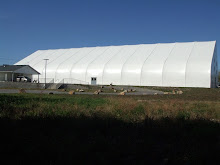A good discussion of the issues can be found on the Trib board, and related articles can be found here and here. And what I write here will be a partial repeat of a post I wrote on the Trib board, so forgive the repetition for any readers who may have already picked up the discussion there.
This is mostly a training blog, and I'm not going to get into any discussion here of what I think CMHS can do, or any possible problems with CMHS or their board or way of doing business. I will say that they work very hard for the animals. They have a great foster program, they work with breed rescues, they use PetFinder and are staffed with extremely hardworking, caring people.
In many parts of the country euthanasia rates are way down. In some parts of the country, believe it or not shelters are actually importing puppies for placement because they don't have enough. Why is Missouri and Columbia such an exception? Why does the CMHS have to deal with so many intakes?
It's easy to point fingers and say it's because Missouri is a puppy mill state and too many people are breeding dogs. But that's too simplistic. The truth of the matter is that nationwide we have less of a surplus dog problem than we have a careless, irresponsible owner problem. Most dogs coming into the shelter had homes. So homes are out there. But they're being dumped because owners treat dogs and puppies like a toaster or a stuffed toy, something to get on impulse, use for awhile, then discard.
The truth is, in almost all cases the excuses people make for dumping their pets are just that. Lame justifications for shucking a responsibility they took on when they got an animal. No, dogs are not children. But they are intelligent, living critters who demand very little for what they return. A bit of training, some willingness to invest in vet care, a brushing, and most importantly, affection. That's what dogs need. If we here in Central Missouuri are not willing to give those basic things, then we, as a group, need to not own dogs.
So part of what I see as a general failing in this area is working more on helping owners keep the dogs they get. But it seems like many/most simply don't want to bother with fencing, leashes, spay/neuter, training, or shots. I admit to being boggled by that and at a loss myself on how to influence people to think beyond "oooh, that's a cute puppy let's take it home." CCSC works hard to try to help people in this area, but they do need to come to us before we can help.
As a city, the dog problems do affect us all, even those who do not have or wish to have a dog. Careless dog people let their dogs roam, terrorizing children and other dogs, leaving poop everywhere. They don't give their dogs shots or worm them, so when they're roaming they're spreading disease. They don't spay/neuter or control access to their unaltered pets, so the market is flooded with puppies who are carelessly placed with those people who get a puppy on impulse. Then the cycle continues again.
CMHS has some problems I'm sure. But we, as a community, need to point our fingers at ourselves. Nine thousand dogs a year?! That's ludicrous! That is OUR collective faults. So how should we combat it? Here's how you can help stem the supply.
- Don't get pets on impulse. Realize that when you get a pet you're taking on an expensive, time-consuming 10-15 year project. Yes, it will puke on your favorite chair. Yes, it will shed on your business suit. Don't want that? Don't get a pet.
- Get regular veterinary care for your pet. Shots, worming, exams. Heartworm, flea prevention.
- Spay/neuter your pet. Even if your pet is purebred, it should not be bred unless you have a championship, multiple genetic health tests, and working titles (and maybe not even then). Being a lovely pet with a sweet personality is not justification to breed. Ever.
- Groom your pet. Keep your pet clean and brushed. He'll be far happier
- Confine your pet. Columbia has a leash law. It's pretty specific. On leash at ALL times unless in designated off leash area or in specific training situations. Specific training does not include letting your dog out the door to wander the neighborhood while you watch TV. A fenced yard or a leash. Those are your two choices.
- Pick up after your pet. Yes, that's the law too. It may seem silly, but think about it from another perspective. Do you want your kid stepping in dog poop riddled with salmonella and e. coli? I bet not. There are baggies available at most parks, or use a plastic grocery bag. If you feed a quality food, it shouldn't be that big a deal.
- Exercise your pet. Dogs are athletic critters. Keep them fit with exercise and they will be healthier, happier, and less likely to indulge in destructive behaviors. A tired dog is a good canine citizen.
- Train your pet. Dogs need mental as well as physical exercise. They're incredibly smart. Give their brains something to do. A trained dog is a well-behaved companion. An investment in classes and your training time yields lifetime rewards.
- Keep your pet. You chose to get an animal. Even when circumstances change, there's almost always a way to keep your pets. Don't take the easy way out and dump your animal. They ask for so little and give so much. Keep them. Don't dump them.





